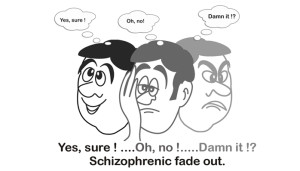What is a Schizophrenic Organisation?
In the clinical sense, schizophrenia implies a split between a person’s thought and emotions. Schizophrenics display inappropriate thought patterns that often do not match the emotions displayed. Or they display emotions that fail to match the situation.(Diane Keyser Wentworth,The Industrial-Organizational Psychologist, April 2002).

If an individual can suffer from schizophrenia it is not illogical to imagine that organisations—which, essentially comprise people as an important resource—can also turn schizophrenic. Organisations are prone to entrap themselves into a cultural churn when they try to reach out for two or more opposing business objectives. One striking but common example is: (1) Maximise customer satisfaction as a matter of top priority and at the same time (2) Ensure maximum enhancement of shareholder value as budgeted. That this highly debilitating cultural turmoil does occur has been confirmed by empirical research, but let us look at some backdrop of the entire phenomenon..
Customer Service Raised to the Level of Business Strategy
Two major reasons have raised the need for delivering superior customer service to the level of top strategic priority worthy of serious attention both in word and in action:
1. The age of customer capitalism has turned the customer into a real ‘king’—better informed, more demanding and less indulgent.
2. Matured technologies have diminished the potential for sustained product differentiation in terms of basic design, features and customer ben¬efits. On the other hand, superior, value-adding customer service offers a great potential to create significant competitive differentiation that keeps the customers emotionally engaged.. A large number of companies were convinced that for getting and retaining customers in their fold they would have to create and sustain a competitive edge on consistent delivery of highly responsive, value-adding service. Also, the front-line employees would have to show considerable maturity and confidence to get the customers emotionally engaged with the company. If the foregoing reflects good intent and use of best practices, the question is why even well-meaning, well-equipped companies often fail to deliver the promised quality of service? Why is there a gap between intent and implementation?
Empirical Research Provides the Answer
Targeted empirical research—spanning over 3 years (2007-2011), 12 companies and 200 customer-touching professionals as respondents—provided clear evidence that the companies beset with the organisational schizophrenia constituting the following traits and more, just cannot deliver promised quality of service:
1. conflict of priorities driven by loss of objectivity,
2. unpunished violations of company’s core values,
3. distorted perception of self-interest,
4. low employee engagement and
5. Unpredictable employees’ behaviour. attribute
The Root Cause
Let us examine what is the genesis of these traits in the first place. The research findings reveal that despite declaring ‘maximising customer satisfaction’ as the topmost priority, company’s executives continue to treat—quite often with tacit approval—‘maximising shareholder value’ as a more sacrosanct overriding and self-serving performance target. According to the optimisation theory, a firm cannot maximise both customer value and shareholder value at the same time. Any attempt to pursue such incongruent goals can only end up in internal conflict within the company. It is this perpetual conflict that finds its expression in a company all the way down to the front line em¬ployees and all those traits listed earlier begin to show up in people’s behaviour. All these are the symptoms of the impending onset of organisational schizophrenia. In this kind of workplace climate no company can deliver quality customer service.
This phenomenon of organisational schizophrenia is not confined to any geographical boundaries. After more than a year of my association with Linkedin and active participation in discussions related to customer service management I found striking similarities in the problems being faced all over the world. You go into the details and you find that the failure to deliver promised service boils down to the fundamental conflict: maximisation of customer satisfaction without giving up on maximisation of shareholder value. And hence the schizophrenic behaviour.
The way Forward
My book—Organisational Schizophrenia—deals comprehensively with the human and organisational game playing that creates schizophrenia and also suggests what can company leadership do about it. But if I were to sum it up in two short sentences I would say:
1. Customer First: If you mean it say it upfront, in word and in action.
2. Culture of Discipline: Consistently apply exacting standards consistent with the company’s mission and core values, at all times and at all levels, especially in upper management.
